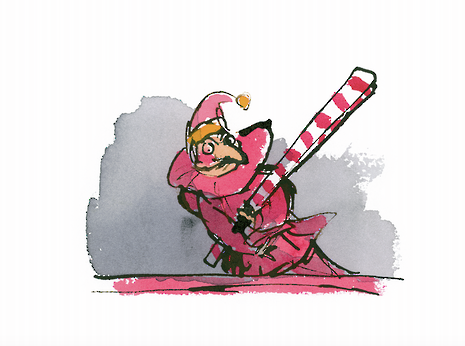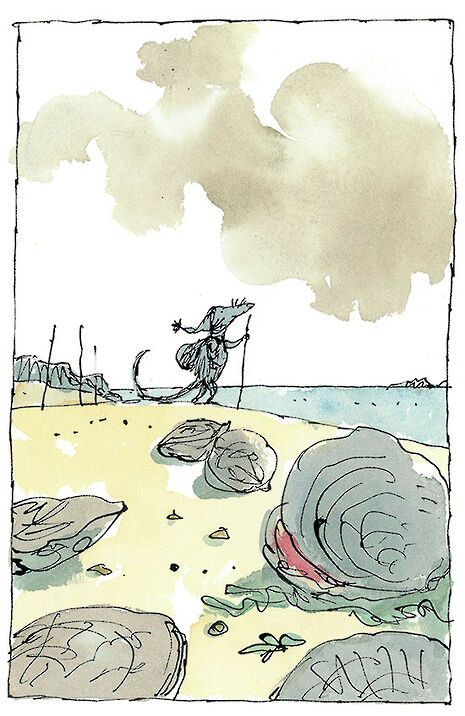Review: The Best of All Possible Worlds at Downing’s Heong Gallery
Anna McGee gives her verdict on the Heong’s summer exhibition, featuring works by Downing alumnus and illustrator extraordinaire Quentin Blake

For many of us, Quentin Blake illustrated our childhood. The BFG, James and the Giant Peach, Matilda… we inevitably associate so many of Roald Dahl’s stories with Blake’s exuberant, scruffy ink drawings. This summer, Downing College’s Heong Gallery is exhibiting original works from some of the artist’s newer commissions, for special-edition publisher The Folio Society, and introduces us to a whole new array of his literary subject matter. The exhibition, entitled The Best of All Possible Worlds, presents a mixture of playful humour, wry satire and even dystopian gloom, but always in that trademark style. It reminds us why we love Quentin Blake, while also revealing another side to him.
“The artist used deteriorated quills (instead of his usual, finer cursive nib) and dark-grey washes to convey the coarseness and desolation of a post-apocalyptic world.”
The Heong Gallery, somehow both homely and minimalist, is the perfect site for Blake’s creations. As we enter the foyer, the first artwork to confront us is hung over a small domestic fireplace. It is a watercolour self-portrait, depicting Blake at his desk hunched over a manuscript of Don Quixote, with a giant thought bubble rising above him: as he reads, he is vividly conjuring in his mind’s eye a scene from the novel. We are able to glimpse Blake’s creative process, the literary spark igniting the visual imagination.
’Quentin Blake thinking about Don Quixote’ is the ideal introduction to the rest of his oeuvre on display, which occupies the luminous interior of the gallery. Its whitewashed walls don’t dominate the small, often spindly line drawings, but rather let them speak for themselves. They are mounted on a plain white background and simply framed, random splashes of paint around the sides of the image reminding us of the artist’s messy, enthusiastic practice.

In the exhibition, famous literary works of all eras – from ancient myths to modern science fiction – have been blessed by Blake’s quill. The artist himself chose to illustrate 50 of the seventeenth-century Fables of La Fontaine, a collection of moral tales taken in part from Aesop. Blake asked in a letter to the publisher, “What’s the point of printing a book if it isn’t illustrated?” and describes the finished fable collection as “a picture book”, with a drawing opposite each poem. Many of the themes discussed are universal and appeal to adults and children alike – the ‘Fable of the Rat and the Oyster’, for instance, playfully warns us against greed and naivety – but Blake also illustrates some of the more ‘grown-up’ tales, capturing the sordid nature of scenes such as ‘The Drunkard and his Wife’. He wanted to “match both the lightness and seriousness” of La Fontaine’s words, and his use of colour washes especially allows him to experiment with differences in tone. Blake’s more sardonic side comes out in his caricaturing illustrations for Voltaire’s eighteenth-century novella Candide, from which the exhibition’s title is drawn, and perfectly complements the satirical nature of the text. Every time, the artist works in harmony with the author, whilst also preserving his unique style of illustration.
Blake’s illustrations for Russell Hoban’s 1980 dystopian novel Riddley Walker are shockingly bleak and crude creations, for which the artist used deteriorated quills (instead of his usual, finer cursive nib) and dark-grey washes to convey the coarseness and desolation of a post-apocalyptic world. Blake recalls that the first time he read Riddley Walker, he immediately had ‘a mental vision of the darkness and the dogs’, and one drawing on display brings this imagining to life, the slate-coloured sky punctuated only by an eerie purple moon and the rabid dogs conjured by a few rough black strokes.
It is strange to consider these works out of their bibliographical contexts: each drawing is isolated from the words it is intended to accompany, the page number jotted down in pencil under the work as the only indicator of its illustrative function. Only a single book is exhibited, in a display case in the centre of the room. It is deluxe edition of Riddley Walker, opened to reveal a nightmarish double-page illustration. The image occupies almost half the page, an equal partner rather than a mere adjunct to the text.
Yet perhaps it is important to view the rest of Blake’s drawings away from their literary counterparts: we realise that they can be considered as works of art in their own right, brilliantly able to tell a story without having to lean on the text for support. As the gallery setting helps us appreciate, Quentin Blake is not just an illustrator, but an artist
 News / Uni offers students £55k in payouts31 October 2025
News / Uni offers students £55k in payouts31 October 2025 News / Uni error forces deeper spending cuts31 October 2025
News / Uni error forces deeper spending cuts31 October 2025 News / College rowing captains narrowly vote to exclude trans women31 October 2025
News / College rowing captains narrowly vote to exclude trans women31 October 2025 News / Students launch women’s society excluding trans women31 October 2025
News / Students launch women’s society excluding trans women31 October 2025 News / Cambridge launches plan to bridge ‘town and gown’ divide27 October 2025
News / Cambridge launches plan to bridge ‘town and gown’ divide27 October 2025









